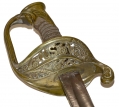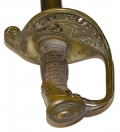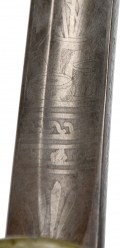site search
online catalog
“THE FEDERALS FOUGHT LIKE DEVILS:” PRESENTATION CAVALRY OFFICER’S SABER OF JAMES B. TALBOT, 1st INDIANA CAVALRY, DEFENSE OF PINE BLUFF

$2,250.00 SOLD
Quantity Available: None
Item Code: 1117-96
This is a good example of presentation cavalry officer’s sword that was intended for active field service and saw it. The hilt and scabbard are set up like an 1850 staff and field sword, but the blade is an etched cavalry officer’s style, making it technically non-regulation, but eminently practical. The brass hilt bears the regulation leaves along the pommel cap and has an open work guard cast and chased with floral scrolls between integral branches with a floating “U.S.” and downward curling quillon. The grip is the standard 1850-style as well, with sharkskin wrap and twisted wire binding. The brass has a medium age patina with some areas showing some rubbing to bright, but just a few traces of gilt in recessed areas. The grip wrap is complete, but shows wear from handling. The blade pad is missing from the underside of the guard.
The blade has an unstopped fuller and two small stamps on the obverse ricasso indicating it is French made, but both sides are etched with U.S. motifs among floral military elements. The obverse starts with a palmette at bottom, a stand of arms with a liberty cap on pole at center, flanked by furled flags, with floral scrolls above and an American eagle with U.S. shield on its chest, clutching arrows and olive branch, and a scroll overhead reading “E Pluribus Unum.” The reverse has a similar palmette at bottom and stand of arms including drums and a liberty cap on a pole, followed by floral scrolls and a block “U.S.” The edge and point are good. The etching is fully visible. The blade shows a muted silver gray with some dark spots.
The scabbard is constructed with a metal body and brass mounts typical of an 1850 staff and field, showing nice blue-turned-plum color with good surface having just light a crustiness here and there. The mounts have an untouched patina matching the hilt and are conventional in form for a staff and field, having a separate throat, upper and lower wide ring mounts with scalloped edges, and matching drag. The drag shows some dents and dings on both sides, but nothing unexpected on a sword with some field service. The carrying rings are in place, as are the screws on all the mounts. The upper mount is nicely engraved: “Presented to / Lieut. Jas. Talbott / by / Co. D 1st Regt Ind Cavl.”
James B. Talbott was 35 years old and a resident of Mount Vernon, Indiana, when he enlisted 8/20/1861, leaving behind a wife and four children. His regiment was first designated the 28th Indiana and then assigned to cavalry service as the First Indiana Cavalry. He was commissioned 2nd Lieutenant of Co. D to date 8/20/61 served with the regiment first in Missouri and then in Arkansas, where it spent most of its service, being engaged in several larger fights, including a cavalry charge at Fredericktown, MO, in October 1861, the fight at Round Top, AR, in mid-1862, and battles at Helena and Pine Bluff in 1863. Talbott made 1st Lieutenant 3/25/62 and Captain 10/17/62.
The outfit cut its teeth, however, in a large number of expeditions and scouts. To increase their firepower and maintain their mobility, they were even equipped with a section of small rifled cannon, variously described as steel two-pounders, and sometimes thought to be Woodruff guns, starting in mid-1862. This fit with the fighting disposition of their brigade commander Col. Powell Clayton, who was given command of the 1st Indiana and his own 5th Kansas. A Confederate serving under Joe Shelby later recalled that Clayton was, “an officer of activity and enterprise, clear-headed, quick to conceive, and bold and rapid to execute. His success in the field has caused him...to be considered the ablest Federal commander of Cavalry west of the Mississippi.”
Under Clayton’s command they held the right of the Union line in the defense of Helena by Benjamin Prentiss and the taking of Little Rock by General Steele, but their finest moment may have been the defense of Pine Bluff in October 1863, where the two regiments and one company of Missouri Militia, about 550 men total, were attacked by roughly 2,300 cavalry under John Marmaduke, who also outnumbered them in artillery with about 12 guns to 9. The fight lasted for several chaotic hours as artillery on both sides demolished buildings and fire broke out in houses, warehouses, and large bales of cotton used for barricades.
Talbott, by then captain of Co. D, was also acting as, “superintendent of contrabands,” several hundred freedmen who had fled to the protection of the Union garrison. They were housed in two camps outside the town and in no way interested in returning to slavery. As skirmishing began outside of town, Talbott organized a group of some 300, who first rolled out bales of cotton from warehouses in the town to barricade the streets surrounding the courthouse and town square. “From the short space of time in which every street and opening was blockaded you may judge their efficiency in that respect, especially when you consider that much of the work was accomplished under a heavy fire from the enemy’s skirmishers,” wrote Talbott in his official report to Clayton. As the fight became general, “calls for water were urgent to supply the soldiers and quench the fire that had caught to the cotton-bales from our artillery,” and Talbot organized a bucket brigade to bring up water from the river’s edge: “at this time a galling fire that opened on them from the enemy killed 1, wounded 3, and for a moment threw them all into confusion, but they were soon rallied, and resumed their work with the most astonishing rapidity. About this time the danger was imminent of the enemy making a charge down the river under cover of the bank… a breastwork was immediately formed under the bank, and while engaged in this work another was wounded. Fifteen of them had arms, and were ordered to hold the point along the river, which they did throughout the action, some of them firing as many as 30 rounds, and one actually ventured out and captured a prisoner. None of them had ever before been in a battle, and the facility with which they labored and the manly efforts put forth to aid in holding the place excelled my highest expectations, and deserves the applause of their country and gratitude of the soldiers. Their loss is 5 killed and 12 wounded,” more than suffered either the 1st Indiana and Missouri State Militia. After several hours of fighting and making no progress, Marmaduke pulled back, reporting later that, “the Federals fought like Devils.”
The regiment remained in Pine Bluff, or what was left of it, after the battle. Talbott resigned to return home in April 1864. Archive records will likely supply the details, but disability from the rigors of campaigning would not be unlikely: the army had suffered remarkable numbers of sick during the campaign for Arkansas River valley. Whatever the reason, he seems to have returned home to his wife and children, fathering one more son before dying in 1869. His widow returned to her native Kentucky by 1875, but we find at least one son who remained in the Mount Vernon area.
This is a very good presentation cavalry officer’s sword showing light wear from real field use and carried by an officer with an active and interesting fighting record.
~~~~~~~~~~~~~~~~~~~~~~~~~
THIS ITEM, AS WITH ALL OTHER ITEMS AVAILABLE ON OUR WEB SITE,
MAY BE PURCHASED THROUGH OUR LAYAWAY PROGRAM.
FOR OUR POLICIES AND TERMS,
CLICK ON ‘CONTACT US’ AT THE TOP OF ANY PAGE ON THE SITE,
THEN ON ‘LAYAWAY POLICY’.
THANK YOU!
Inquire About “THE FEDERALS FOUGHT LIKE DEVILS:” PRESENTATION CAVALRY OFFICER’S SABER OF JAMES B. TALBOT, 1st INDIANA CAVALRY, DEFENSE OF PINE BLUFF
For inquiries, please email us at [email protected]
Most Popular
Historical Firearms Stolen From The National Civil War Museum In Harrisburg, Pa »
Theft From Gravesite Of Gen. John Reynolds »
Cavalry Carbine Sling Swivel »
Fine Condition Brass Infantry Bugle Insignia »
featured item
VERY SCARCE SWAN CONTRACT VIRGINIA MILITIA REGIMENTALLY MARKED MUSKET, CIRCA 1799: COMPANY C, 54th REGIMENT, NORFOLK BOROUGH
This musket follows the general lines of a British Short Land Pattern musket, but bears no British maker, ordnance, or proof marks. The lock is a two-screw lock with gooseneck hammer, rounded pan and no external bridle. The lockplate is stamped with… (1000-0255). Learn More »























